But you just keep coming back!
Article
by Dave Antonucci
"In a nut shell, we lost the entire dredge sans diving gear and had our camp smashed to bits by bears. ”
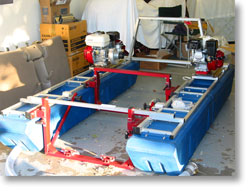 Well mother nature just plain kicked out butts last winter. Part of owning a remote mining claim means that you will be “caching” your equipment on site. The terrain is much too rugged to take all the equipment up and out of our canyon each fall so we have created a couple of camps on our claim. One for our camping/living area and another, further down stream, for the equipment. Nothing out of the ordinary for Sierra placer miners….other than we were making some poor decsions on how to manage our stuff. In a nut shell, we lost the entire dredge sans diving gear and had our camp smashed to bits by bears.
Well mother nature just plain kicked out butts last winter. Part of owning a remote mining claim means that you will be “caching” your equipment on site. The terrain is much too rugged to take all the equipment up and out of our canyon each fall so we have created a couple of camps on our claim. One for our camping/living area and another, further down stream, for the equipment. Nothing out of the ordinary for Sierra placer miners….other than we were making some poor decsions on how to manage our stuff. In a nut shell, we lost the entire dredge sans diving gear and had our camp smashed to bits by bears.
"I recall sitting on a rock creekside questioning
whether I wanted to continue this hobby or not.”
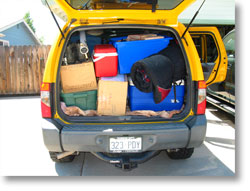 The winter of 04-05 was a good one by mining standards. Gold migrates only when there is some form of heavy erosion. The “100 Year Storm” that hit the Sierra’s about every 25 years in reality, just tear up the mountainsides and stream beds redeposting the gold and adding some new nuggets to the mix. I’m talking about the kind of storms that flood places like Yuba City and Marysville or wipes out sections of Hwy 49 up along the Yuba River. We had one of those monster storms in 97 and while the storms of 04-05 were not of that caliber they were pretty powerful. We have had another big flood season this year with all the warm rain mid winter and now a tremendous snow pack with above average spring temperatures. So with that in mind, this year the gold hunting should be very good…the problem is the dredge went bye bye in the 04-05 flood. We were not able to make it to the claim in early fall which is when we typically pull the equipment and stash it high and dry for the winter. We had some very early snow, I believe it was October 2nd that we had our first snow fall and then again mid month. We did attempt to 4x4 it in but turned around after about 20 miles of the 25 that it takes to get to our jumping off point. The snow was just too deep. I didn’t feel like rolling my Xterrr off a cliff!
The winter of 04-05 was a good one by mining standards. Gold migrates only when there is some form of heavy erosion. The “100 Year Storm” that hit the Sierra’s about every 25 years in reality, just tear up the mountainsides and stream beds redeposting the gold and adding some new nuggets to the mix. I’m talking about the kind of storms that flood places like Yuba City and Marysville or wipes out sections of Hwy 49 up along the Yuba River. We had one of those monster storms in 97 and while the storms of 04-05 were not of that caliber they were pretty powerful. We have had another big flood season this year with all the warm rain mid winter and now a tremendous snow pack with above average spring temperatures. So with that in mind, this year the gold hunting should be very good…the problem is the dredge went bye bye in the 04-05 flood. We were not able to make it to the claim in early fall which is when we typically pull the equipment and stash it high and dry for the winter. We had some very early snow, I believe it was October 2nd that we had our first snow fall and then again mid month. We did attempt to 4x4 it in but turned around after about 20 miles of the 25 that it takes to get to our jumping off point. The snow was just too deep. I didn’t feel like rolling my Xterrr off a cliff!
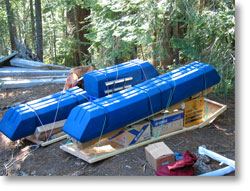 Come late May we headed back up to asses the damage. The dredge was MIA and our camp had been trashed by some ravenous post hibernation bears. Our food barrels were torn apart or missing, our 12 foot table was smashed to bits but overall the camping equipment was left alone. What a dissapointing day that was. I recall sitting on a rock creekside questioning whether I wanted to continue this hobby or not. It was all very depressing and hard to look at.
Come late May we headed back up to asses the damage. The dredge was MIA and our camp had been trashed by some ravenous post hibernation bears. Our food barrels were torn apart or missing, our 12 foot table was smashed to bits but overall the camping equipment was left alone. What a dissapointing day that was. I recall sitting on a rock creekside questioning whether I wanted to continue this hobby or not. It was all very depressing and hard to look at.
Durring the rest of that summer we were able to retreive a few parts off the missing dredge either burried in sand banks or just deposited high up on the creeks edge from the flood waters. There were enough of the expensive componants, in usable condition, to justify a reconstruction vs purchasing a whole new dredge. Store bought dredges start at about $4,500 for a dual engine 6”. Our needs would set us back more like $5,500 for a fully fitted out dredge. Well the fire hadn’t quite gone out completely so I took it upon myself to build a new dredge. My motivation was to not only construct it for under what a replacement dredge would cost but also to combine the best of all concepts and add a few frills. Now that sounded like fun! I would have to purchase all kinds of new tools while adding a few cool deivces to my home shop. Darn don’t you hate that? Honey I’m going to Lowes again….
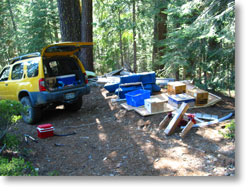 If your not familiar with suction dredge technology this is how it works. The heart of any dredge will be its jet pipe. It’s a steal tube, about 5 feet long, 6” in daimeter (hence our refference to a 6” dredge) with two small “jet logs” or pipes that enter the main big pipe at a severely low angle at the underwater end. They point upwards, out of the water, towards the sluice box. Two 6.5 HP Honda engines with high pressure water pumps will be attached to the jet logs. The bottom half of the jet pipe, the end with the jet logs, sits under water, with the jet logs aiming upwards, away from the bottom end of the big pipe, which creates strong suction. You attach a flexable 25’ foot 6” hose to the suction end which is what you use to vacume the river bed. The other end of the jet pipe exits above the water line into a 7’ long aluminum sluice box. Its there that all the mud and gravel is classifed out leaving just the heavy stuff behind some riffles the run across the bottom of the sluice box. Hopefully there is gold in the heavy concentrates sitting behind each riffle. The rest of the dredge is just aluminum framing, pontoons, tool holders etc. Of course you have two engines to place properly along with a small belt driven air compressor that feeds a pressure tank that in turn supplies up to two divers on Hooka or teathered air hose style diving regulator. As long as the engines are running you have air being supplied to your hose man or the person doing the actual vacuming under water. The other guy hucks the bigger rocks out of the dredge hole and makes sure the sluice is staying clear of debris. Much of his day will be raking the taling pile away from the exit end of the sluice box. If you have your jet pipe and sluice desinged properly you can move up to a cubic yard every three minutes with a 6” dredge. That’s a lot of gravel and the tailings will pile up quickly.
If your not familiar with suction dredge technology this is how it works. The heart of any dredge will be its jet pipe. It’s a steal tube, about 5 feet long, 6” in daimeter (hence our refference to a 6” dredge) with two small “jet logs” or pipes that enter the main big pipe at a severely low angle at the underwater end. They point upwards, out of the water, towards the sluice box. Two 6.5 HP Honda engines with high pressure water pumps will be attached to the jet logs. The bottom half of the jet pipe, the end with the jet logs, sits under water, with the jet logs aiming upwards, away from the bottom end of the big pipe, which creates strong suction. You attach a flexable 25’ foot 6” hose to the suction end which is what you use to vacume the river bed. The other end of the jet pipe exits above the water line into a 7’ long aluminum sluice box. Its there that all the mud and gravel is classifed out leaving just the heavy stuff behind some riffles the run across the bottom of the sluice box. Hopefully there is gold in the heavy concentrates sitting behind each riffle. The rest of the dredge is just aluminum framing, pontoons, tool holders etc. Of course you have two engines to place properly along with a small belt driven air compressor that feeds a pressure tank that in turn supplies up to two divers on Hooka or teathered air hose style diving regulator. As long as the engines are running you have air being supplied to your hose man or the person doing the actual vacuming under water. The other guy hucks the bigger rocks out of the dredge hole and makes sure the sluice is staying clear of debris. Much of his day will be raking the taling pile away from the exit end of the sluice box. If you have your jet pipe and sluice desinged properly you can move up to a cubic yard every three minutes with a 6” dredge. That’s a lot of gravel and the tailings will pile up quickly.
The whole kit and kaboodle, sans suction hose, is near 12’ in length and about 4’ wide from pontoon to pontoon. The weight ranges with the store boughts hitting about 475 lbs. I should have our custom aluminum dredge down to around 375 lbs.
"With luck we may break even this year!”
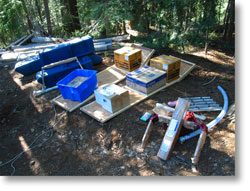 I would guess that our new dredge is about 90% complete as of mid May. I ended up selling most of our gold on e-bay to fund this project which was not easy to part with but it just seemed like the right thing to do.
I would guess that our new dredge is about 90% complete as of mid May. I ended up selling most of our gold on e-bay to fund this project which was not easy to part with but it just seemed like the right thing to do.
At this point motivation is high and the winter has finally come to an end. It’s about this time of the year that all dredgers start to feel anxious. We e-mail each other, ask about which weekends are set aside, how much snow there will be in our claims etc. Before we know it the snow will be gone and the mountain wild flowers will be blooming all along Historic Hwy 49. We will have some hardy working weekends right off the bat as we will need to haul in all of the new equipment, new tables and even (2) 60 lb weight belts down a 1500 foot rope that will dump us a third of a mile from our claim. There will be a tremendous amount of trudging, sweating and mosquitoes waiting for us this spring. It’s a good thing we call this fun because someone might look at this as work and that would just completely ruin the whole deal! If this were business then we would have pretty much gone chapter 11 but its not, it’s a labor of love so the price tag is not so important. With gold hitting $700 an ounce there is some extra urgency to get our mining efforts underway. With luck we may break even this year!
So here we are making plans, conscripting strong friends for the big push and keeping our fingers crossed. The season is near and the fever has once again taken hold. I can’t wait to camp out under the fragrant sugar pines. To the mines!
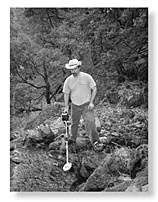
Click
here for another of Dave's ariticles
Free
Gold!
A
Promise of Gold...
Articles
by Dave Antonucci.



 W
W The winter of 04-05 was a good one by mining standards. Gold migrates only when there is some form of heavy erosion. The “100 Year Storm” that hit the Sierra’s about every 25 years in reality, just tear up the mountainsides and stream beds redeposting the gold and adding some new nuggets to the mix. I’m talking about the kind of storms that flood places like Yuba City and Marysville or wipes out sections of Hwy 49 up along the Yuba River. We had one of those monster storms in 97 and while the storms of 04-05 were not of that caliber they were pretty powerful. We have had another big flood season this year with all the warm rain mid winter and now a tremendous snow pack with above average spring temperatures. So with that in mind, this year the gold hunting should be very good…the problem is the dredge went bye bye in the 04-05 flood. We were not able to make it to the claim in early fall which is when we typically pull the equipment and stash it high and dry for the winter. We had some very early snow, I believe it was October 2nd that we had our first snow fall and then again mid month. We did attempt to 4x4 it in but turned around after about 20 miles of the 25 that it takes to get to our jumping off point. The snow was just too deep. I didn’t feel like rolling my Xterrr off a cliff!
The winter of 04-05 was a good one by mining standards. Gold migrates only when there is some form of heavy erosion. The “100 Year Storm” that hit the Sierra’s about every 25 years in reality, just tear up the mountainsides and stream beds redeposting the gold and adding some new nuggets to the mix. I’m talking about the kind of storms that flood places like Yuba City and Marysville or wipes out sections of Hwy 49 up along the Yuba River. We had one of those monster storms in 97 and while the storms of 04-05 were not of that caliber they were pretty powerful. We have had another big flood season this year with all the warm rain mid winter and now a tremendous snow pack with above average spring temperatures. So with that in mind, this year the gold hunting should be very good…the problem is the dredge went bye bye in the 04-05 flood. We were not able to make it to the claim in early fall which is when we typically pull the equipment and stash it high and dry for the winter. We had some very early snow, I believe it was October 2nd that we had our first snow fall and then again mid month. We did attempt to 4x4 it in but turned around after about 20 miles of the 25 that it takes to get to our jumping off point. The snow was just too deep. I didn’t feel like rolling my Xterrr off a cliff! Come late May we headed back up to asses the damage. The dredge was MIA and our camp had been trashed by some ravenous post hibernation bears. Our food barrels were torn apart or missing, our 12 foot table was smashed to bits but overall the camping equipment was left alone. What a dissapointing day that was. I recall sitting on a rock creekside questioning whether I wanted to continue this hobby or not. It was all very depressing and hard to look at.
Come late May we headed back up to asses the damage. The dredge was MIA and our camp had been trashed by some ravenous post hibernation bears. Our food barrels were torn apart or missing, our 12 foot table was smashed to bits but overall the camping equipment was left alone. What a dissapointing day that was. I recall sitting on a rock creekside questioning whether I wanted to continue this hobby or not. It was all very depressing and hard to look at. If your not familiar with suction dredge technology this is how it works. The heart of any dredge will be its jet pipe. It’s a steal tube, about 5 feet long, 6” in daimeter (hence our refference to a 6” dredge) with two small “jet logs” or pipes that enter the main big pipe at a severely low angle at the underwater end. They point upwards, out of the water, towards the sluice box. Two 6.5 HP Honda engines with high pressure water pumps will be attached to the jet logs. The bottom half of the jet pipe, the end with the jet logs, sits under water, with the jet logs aiming upwards, away from the bottom end of the big pipe, which creates strong suction. You attach a flexable 25’ foot 6” hose to the suction end which is what you use to vacume the river bed. The other end of the jet pipe exits above the water line into a 7’ long aluminum sluice box. Its there that all the mud and gravel is classifed out leaving just the heavy stuff behind some riffles the run across the bottom of the sluice box. Hopefully there is gold in the heavy concentrates sitting behind each riffle. The rest of the dredge is just aluminum framing, pontoons, tool holders etc. Of course you have two engines to place properly along with a small belt driven air compressor that feeds a pressure tank that in turn supplies up to two divers on Hooka or teathered air hose style diving regulator. As long as the engines are running you have air being supplied to your hose man or the person doing the actual vacuming under water. The other guy hucks the bigger rocks out of the dredge hole and makes sure the sluice is staying clear of debris. Much of his day will be raking the taling pile away from the exit end of the sluice box. If you have your jet pipe and sluice desinged properly you can move up to a cubic yard every three minutes with a 6” dredge. That’s a lot of gravel and the tailings will pile up quickly.
If your not familiar with suction dredge technology this is how it works. The heart of any dredge will be its jet pipe. It’s a steal tube, about 5 feet long, 6” in daimeter (hence our refference to a 6” dredge) with two small “jet logs” or pipes that enter the main big pipe at a severely low angle at the underwater end. They point upwards, out of the water, towards the sluice box. Two 6.5 HP Honda engines with high pressure water pumps will be attached to the jet logs. The bottom half of the jet pipe, the end with the jet logs, sits under water, with the jet logs aiming upwards, away from the bottom end of the big pipe, which creates strong suction. You attach a flexable 25’ foot 6” hose to the suction end which is what you use to vacume the river bed. The other end of the jet pipe exits above the water line into a 7’ long aluminum sluice box. Its there that all the mud and gravel is classifed out leaving just the heavy stuff behind some riffles the run across the bottom of the sluice box. Hopefully there is gold in the heavy concentrates sitting behind each riffle. The rest of the dredge is just aluminum framing, pontoons, tool holders etc. Of course you have two engines to place properly along with a small belt driven air compressor that feeds a pressure tank that in turn supplies up to two divers on Hooka or teathered air hose style diving regulator. As long as the engines are running you have air being supplied to your hose man or the person doing the actual vacuming under water. The other guy hucks the bigger rocks out of the dredge hole and makes sure the sluice is staying clear of debris. Much of his day will be raking the taling pile away from the exit end of the sluice box. If you have your jet pipe and sluice desinged properly you can move up to a cubic yard every three minutes with a 6” dredge. That’s a lot of gravel and the tailings will pile up quickly. I would guess that our new dredge is about 90% complete as of mid May. I ended up selling most of our gold on e-bay to fund this project which was not easy to part with but it just seemed like the right thing to do.
I would guess that our new dredge is about 90% complete as of mid May. I ended up selling most of our gold on e-bay to fund this project which was not easy to part with but it just seemed like the right thing to do. 